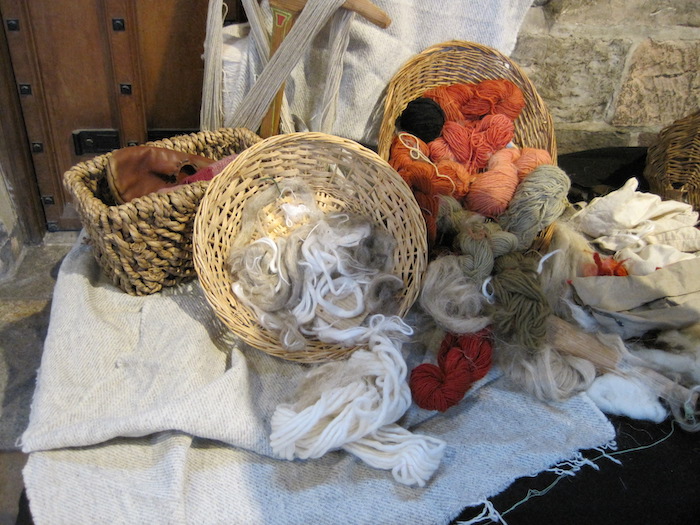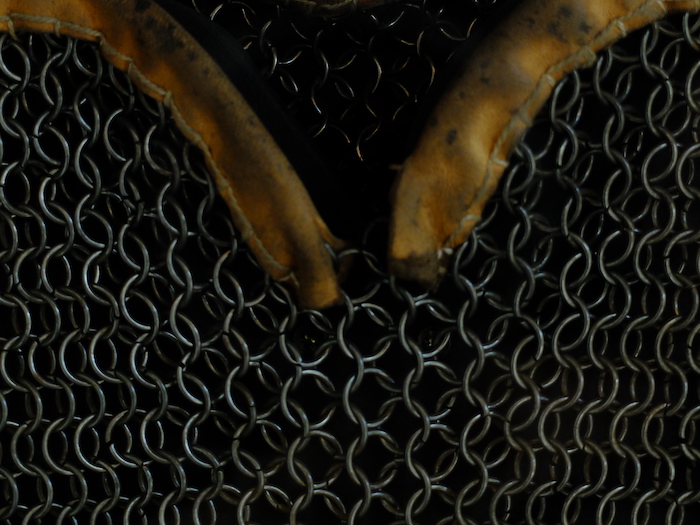Exeter Riddle 35 and the Leiden Riddle
MEGANCAVELL
Date: Mon 09 Feb 2015Matching Commentaries: Commentary for Exeter Riddle 35 and the Leiden Riddle
It’s BOGOFF day at The Riddle Ages! For the low, low (free) price of one riddle, you get two related poems! First, take a look at Riddle 35 from the (West Saxon) Exeter Book. Then scroll down to see the Leiden Riddle, a very similar version in another Old English dialect (Northumbrian). Notice any interesting differences?
Riddle 35
Mec se wæta wong, wundrum freorig,
of his innaþe ærist cende.
Ne wat ic mec beworhtne wulle flysum,
hærum þurh heahcræft, hygeþoncum min.
5 Wundene me ne beoð wefle, ne ic wearp hafu,
ne þurh þreata geþræcu þræd me ne hlimmeð,
ne æt me hrutende hrisil scriþeð,
ne mec ohwonan sceal am cnyssan.
Wyrmas mec ne awæfan wyrda cræftum,
10 þa þe geolo godwebb geatwum frætwað.
Wile mec mon hwæþre seþeah wide ofer eorþan
hatan for hæleþum hyhtlic gewæde.
Saga soðcwidum, searoþoncum gleaw,
wordum wisfæst, hwæt þis gewæde sy.
The Leiden Riddle
Mec se ueta uong, uundrum freorig,
ob his innaðae aerest cæn[.]æ.
Ni uaat ic mec biuorthæ uullan fliusum,
herum ðerh hehcraeft, hygiðonc[…..].
Uundnae me ni biað ueflæ, ni ic uarp hafæ,
5 ni ðerih ðreatun giðraec ðret me hlimmith,
ne me hrutendu hrisil scelfath,
ni mec ouana aam sceal cnyssa.
Uyrmas mec ni auefun uyrdi craeftum,
ða ði geolu godueb geatum fraetuath.
10 Uil mec huethrae suae ðeh uidæ ofaer eorðu
hatan mith heliðum hyhtlic giuæde;
ni anoegun ic me aerigfaerae egsan brogum,
ðeh ði n[…]n siæ niudlicae ob cocrum.
Riddle 35
The wet plain, wonderfully cold,
first bore me out of its womb.
I know in my mind I was not wrought
of wool from fleeces, with hair through great skill.
5 Wefts are not wound for me, nor do I have a warp,
nor does thread resound in me through the force of blows,
nor does a whirring shuttle glide upon me,
nor must the beater strike me anywhere.
The worms who adorn fine yellow cloth with trappings
10 did not weave me together with the skills of the fates.
Nevertheless widely over the earth
someone will call me a fortunate garment for warriors.
Say with true words, clever with skillful-thoughts,
with very wise words, what this garment might be.
The Leiden Riddle
The wet plain, wonderfully cold,
first bore me out of its womb.
I know in my mind I was not wrought
of wool from fleeces, with hair through great skill.
5 Wefts are not wound for me, nor do I have a warp,
nor does thread resound in me through the force of blows,
nor does a whirring shuttle shake upon me,
nor must the beater strike me anywhere.
The worms who adorn fine yellow cloth with trappings
10 did not weave me together with the skills of fate.
Nevertheless widely over the earth
one will call me a fortunate garment for warriors;
nor do I fear terror from the peril of a flight of arrows,
though they be eagerly pulled from the quiver.
Notes:
This riddle appears on folios 109r-109v of the Exeter Book and folio 25v of Leiden, Bibliotheek der Rijksuniversiteit, Vossius Lat. 4o 106.
The above Old English text is based on these two editions: Elliott van Kirk Dobbie and George Philip Krapp, eds, The Exeter Book, Anglo-Saxon Poetic Records 3 (New York: Columbia University Press, 1936), page 198; and A. H. Smith, ed., Three Northumbrian Poems (London: Methuen, 1933), pages 44/46.
Note that this edition numbers the first text Riddle 33: Craig Williamson, ed., The Old English Riddles of the Exeter Book (Chapel Hill: University of North Carolina Press, 1977), pages 88-9.
Tags: anglo saxon exeter book riddles old english solutions riddle 35 leiden riddle
Related Posts:
Commentary for Exeter Riddle 7
Commentary for Exeter Riddles 1-3
Commentary for Exeter Riddle 77


Commentary for Exeter Riddle 34
MEGANCAVELL
Date: Mon 02 Feb 2015Matching Riddle: Exeter Riddle 34
This week’s commentary is also by Corinne Dale of Royal Holloway. Go, Corinne:
Riddle 34 has been widely solved as “rake.” This solution makes perfect sense; anyone who has had the good fortune of becoming acquainted with the simple but effective rake, if only by watching others use one from afar whilst being fanned by palm leaves, will know that its predominant feature is the many “teeth” affixed to its bar. They will also have observed that a rake travels across the ground as it is pulled towards the user. A similar motion is described in Riddle 34; the subject’s nebb (nose) points niþerweard (downwards) and the creature is described as travelling ham (home) (lines 3-4). A rake can be used for weeding, thus explaining the way Riddle 34’s subject leaves behind only the beautiful plants (line 7a), although apparently there is little evidence to say exactly how weeding was carried out in early medieval England (see Banham and Faith, pages 59-60).
A rake can also collect dead grass or dying plants, explaining those plants that fæst ne biþ (are not firmly rooted) in Riddle 34 (line 6b), and can be used to gather in hay, hence the riddle-subject’s ability to feed the feoh (herds) in line 2a. Presumably, the riddle’s wera burgum refers to a human setting, such as a farmstead (line 1b). The reference to weallas (line 5a) takes a little more explanation; Williamson suggests that it could refer to domestic gardening, the walls being the perimeters of the settlement, but also suggests emending the word to wealdas, meaning “forest” (Williamson, page 243). Though forests and woods were used in farming for pasture (Banham and Faith, page 203), it is difficult to imagine a scenario in which a rake would be used among trees.
Very little has been said about Riddle 34 in Old English scholarship; Williamson’s notes and commentary on the riddle are particularly short, among the shortest (perhaps the shortest) in his edition. Yet there are some pretty interesting aspects to the riddle that invite investigation and comment.
Photo of a wooden hand rake (by Chmee2) from the Wikimedia Commons.
Firstly, the riddle-writer’s explicit reference to wyrtum (plants) removes much of the ambiguity from the riddle – why not choose a more ambiguous term to help disguise the answer? Why refer explicitly to blooming and growing as well? Perhaps all this raking business is a metaphor for something else, something that requires a more imaginative leap?
I suggest the answer to the riddle could also be “scholar” or “successful scholar.” The riddle’s description of a creature that has many teeth and a nose pointing downwards brings to my mind the somewhat comic image of a human being with his or her nose buried in a book. We medievalists have all been there, nebb niþerweard…
This gentleman may be an avid scholar or may simply enjoy the smell of books, in which case, fair play. Photograph by Henti Smith, subject to CC BY-NC-ND 2.0 license.
In the growing dark, with just a flickering candle for light, the medieval scholar’s nose would have quite literally been in the pages, much like this fellow’s threatens to:
Portrait of Eadwine (public domain) from the Wikimedia Commons.
Nebb, however, can also be translated as “nib,” which, if we are to read the riddle’s solution as “successful scholar,” would refer to the nib of a scholar’s pen. Interpreted this way, it would be the nib that points downwards and moves across the page (the page being the ground/field), before returning to ham (home), i.e. back to the beginning, the margin. There are depictions of pages as fields in other early medieval riddles, including Aldhelm’s Enigma 59, Penna and Eusebius’s Enigma 32, De membrano.
My interpretation of Riddle 34 is inspired by Fred C. Robinson’s reading of Riddle 47’s bookworm as an unsuccessful scholar who does not take in the words he reads. Robinson notes a number of puns throughout the riddle, including the play on swealgan, meaning both “to swallow” and “to take into the mind, accept, imbibe (wisdom)” (Robinson, page 357). It is possible that Riddle 34 depicts the contrasting concept of the successful scholar in its depiction of a subject that hiþeð holdlice (faithfully plunders), findeð (finds) the ones (i.e. plants or words) that fæst ne biþ (are not firmly rooted) and læteð (leaves) þa wlitigan, wyrtum fæste, / stille stondan on staþolwonge (the beautiful ones, firmly rooted, standing still in their foundation place) (lines 4a-9b). The idea is that the attentive scholar can root out those words that are not valuable but leave those that are more valuable to stand firm, either in his or her mind or on the page. Perhaps this is just the imaginings of a PhD student used to a supervisor’s scrupulous weeding-out of weaker ideas within her thesis and leaving the stronger ones to bloom, but I think the notion is worth pursuing.
Riddle 47’s bookworm is a thief, a plunderer; in Riddle 34 the rake is also a plunderer, but it “plunders faithfully” (or “attentively”) – a bizarre word pairing that perhaps suggests the creature is careful of what it roots up. Both texts refer to foundations, too; Riddle 47 refers to the staþol the worm swallows, whilst Riddle 34 refers to the staþolwonge in which the plants grow. Staþol, says Robinson, can be used to refer to a book’s foundations but can also be used in an abstract sense “to refer to intellectual foundations or to the context of a thought or an argument” (Robinson, page 357). This dual meaning can also be applied to Riddle 34. Likewise, the weallas of Riddle 34 could refer to the “walls” of the book – its covers – whilst also referring to natural walls or the walls of a human settlement. This theory could explain the somewhat peculiar use of weallas in the riddle.
I wonder if the last four lines have religious connotations. Scripture contains references to good and bad seeds, to cultivation and weeds; for example, in the Parable of the Growing Seed, Christ says that a “sower” – one who spreads the Word – will sow some seeds that will necessarily fall by the wayside. He says of these people, “Satan comes immediately and takes away the word that was sown in their hearts”; but there are some people in whom the seed will grow, bloom and bear fruit (Mark 4:14-20). Could Riddle 34’s plants be metaphors for human beings, for the sinners that are uprooted and the faithful that stand firm, bloom and grow? The Exeter Book’s largely pious readership – monks – would no doubt have noted the evocative nature of the imagery, even though the first half of the riddle invites a mundane solution (exhibiting the miraculous in the mundane is what the riddle-writers do, after all). Monks often cultivated their own plots within the monastery grounds, but this metaphorical “weeding” is a type of gardening they would also have been familiar with.
Gardening, Medieval monk-style. Photo by Hans S, subject to CC BY-ND 2.0 license.
An afterthought: I have been talking about male scholars, but the subject of Riddle 34 is apparently female (seo is a feminine pronoun). Why is this? Could this disqualify my solution? Or could this be evidence of (thriving?) female literacy in the later centuries of the early medieval period?
References and Suggested Reading:
Banham, Debby, and Rosalind Faith. Anglo-Saxon Farms and Farming. Oxford: Oxford University Press, 2014.
Robinson, Fred C. “Artful Ambiguities in the Old English “Book-Moth” Riddle.” In Anglo-Saxon Poetry: Essays in Appreciation for John C. McGalliard. Edited by Lewis E. Nicholson and Dolores Warwick Frese. Notre Dame: University of Notre Dame Press, 1975, pages 355-75.
Williamson, Craig, ed. The Old English Riddles of the Exeter Book. Chapel Hill: University of North Carolina Press, 1979.
Tags: anglo saxon exeter book riddles old english solutions riddle 34 corrine dale
Related Posts:
Commentary for Exeter Riddle 47